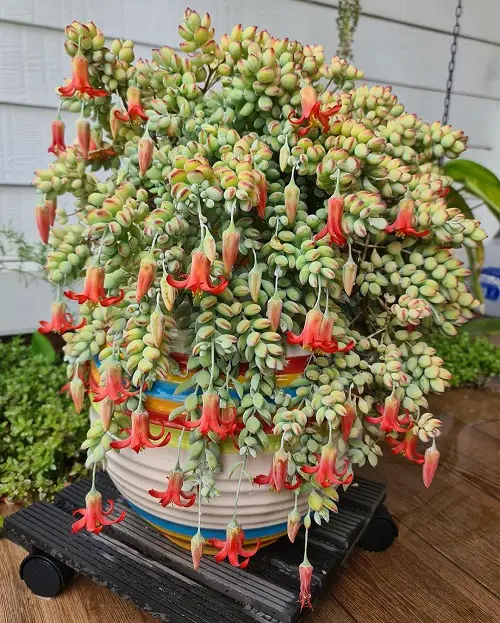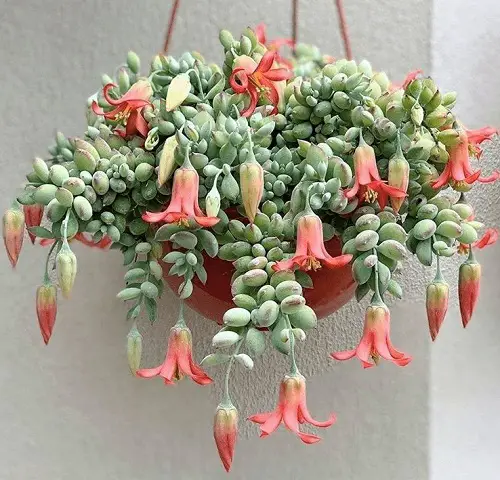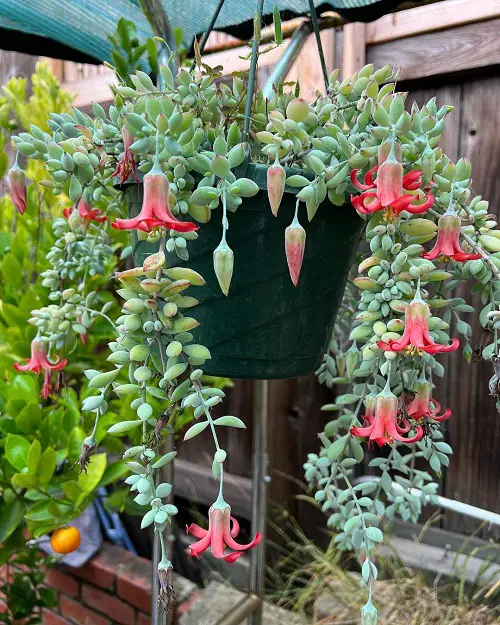Cotyledon Pendens Succulent is one of the most beautiful vining plants! Let’s have a look at how to care for Trailing Cliff Cotyledon!

Cotyledon Pendens Succulent is one the most beautiful trailing plants you can display in hanging baskets! Here are all the details for growing Trailing Cliff Cotyledon.
USDA Zones: 9-11b
Check out the Best Flowering Succulents To Grow Indoors and Outdoors
Cotyledon Pendens Succulent Information
Native to the Eastern Cape in South Africa, Cotyledon Pendens Succulent is a trailing succulent from the Crassulaceae family. This multi-branched plant has hanging stems that grow up to 15-30 inches long.
The inflorescences are branched and have up to 3-4 red-orange, bell-shaped blooms that occur in mid-summer.
Cotyledon Pendens produces chalky, thick, gray-green, and white leaves with red edges covered with glandular hairs that shed with age. The color depends on the temperature, season, drought, and light intensity. In spring and summer, Cliff Cotyledon displays hanging coral, bell-shaped blooms at the ends of the branches.
Have a look at the Modern Indoor Succulent Garden Ideas
How To Grow Cotyledon Pendens Succulent?

Cliff Cotyledon can be grown from cuttings during summer and fall.
- Take the 4-6 inches long stem from the lower part of the plant.
- Remove all four leaves at the end and plant it in a pot filled with well-draining soil.
- Water well and keep the container in a full sun area.
- The cutting will form new growth in 4-6 weeks.
For growing this succulent from offsets, cut the offsets from the stem or base and grow them in cacti soil. In some time, the roots will form.
- Take out an offset with your fingers gently.
- Discard any old leaves, and plant the offset up to 1-2 inches deep in well-draining soil.
- Allow the soil to dry out between waterings.
Requirements for Growing Cotyledon Pendens Succulent

Light
Cotyledon Pendens prefers full sun exposure for at least 3-4 hours every day. Rotate the plant every few days so all sides get light. Do remember, in lack of sufficient light, the plant begins to shed leaves and won’t get that beautiful color on the foliage or blooms.
Soil
Use a well-draining, gritty mix – you can use succulent or cacti mix as well. Alternatively, use equal amounts of pumice, perlite, lava rock, or bark mulch.
Water
This drought-tolerant plant appreciates moist soil but dislikes overwatering. Water the plant when the topsoil feels a little dry to the touch. Do not water the plant daily.
Cotyledon Pendens Succulent Care

Fertilizer
Feed this succulent once or twice a month with a balanced liquid fertilizer. Avoid feeding the plant when it goes into a dormancy stage in winter.
Pests and Diseases
Mealybugs can be a problem. Keep them away by using insecticidal soap or neem oil. Overwatering can result in root rot, so ensure you always water the plant when the soil feels a bit dry.
Toxicity
Keep your pets and children away from Cotyledon Pendens, as ingesting its leaves can be mildly toxic, resulting in vomiting or diarrhea. Contact your veterinary doctor in such conditions.



I’ve had my Cotyledon Pendens for about 7 or 8 months. It was in a southeast facing window. Its new growth doesn’t look like the older leaves. They are not chalky looking, but rather they are bright green, shiny, and not nearly as plump. Why is the plant doing that? I have searched for an answer, but haven’t been able to find one.
Mine too! I have 2 that I purchased, & one that I propagated, all have grown very well, but are shiny green. I hope someone can tell us why!